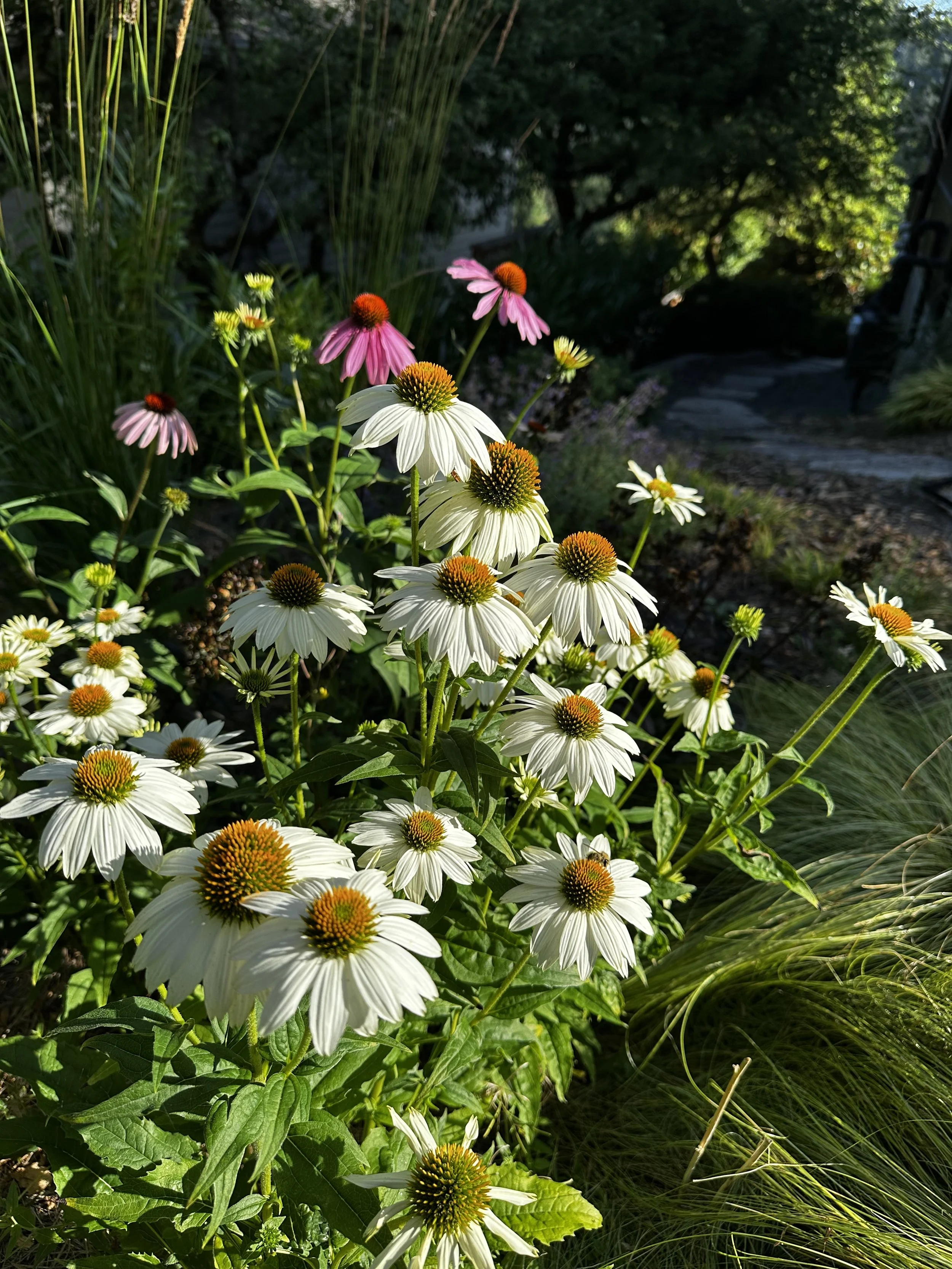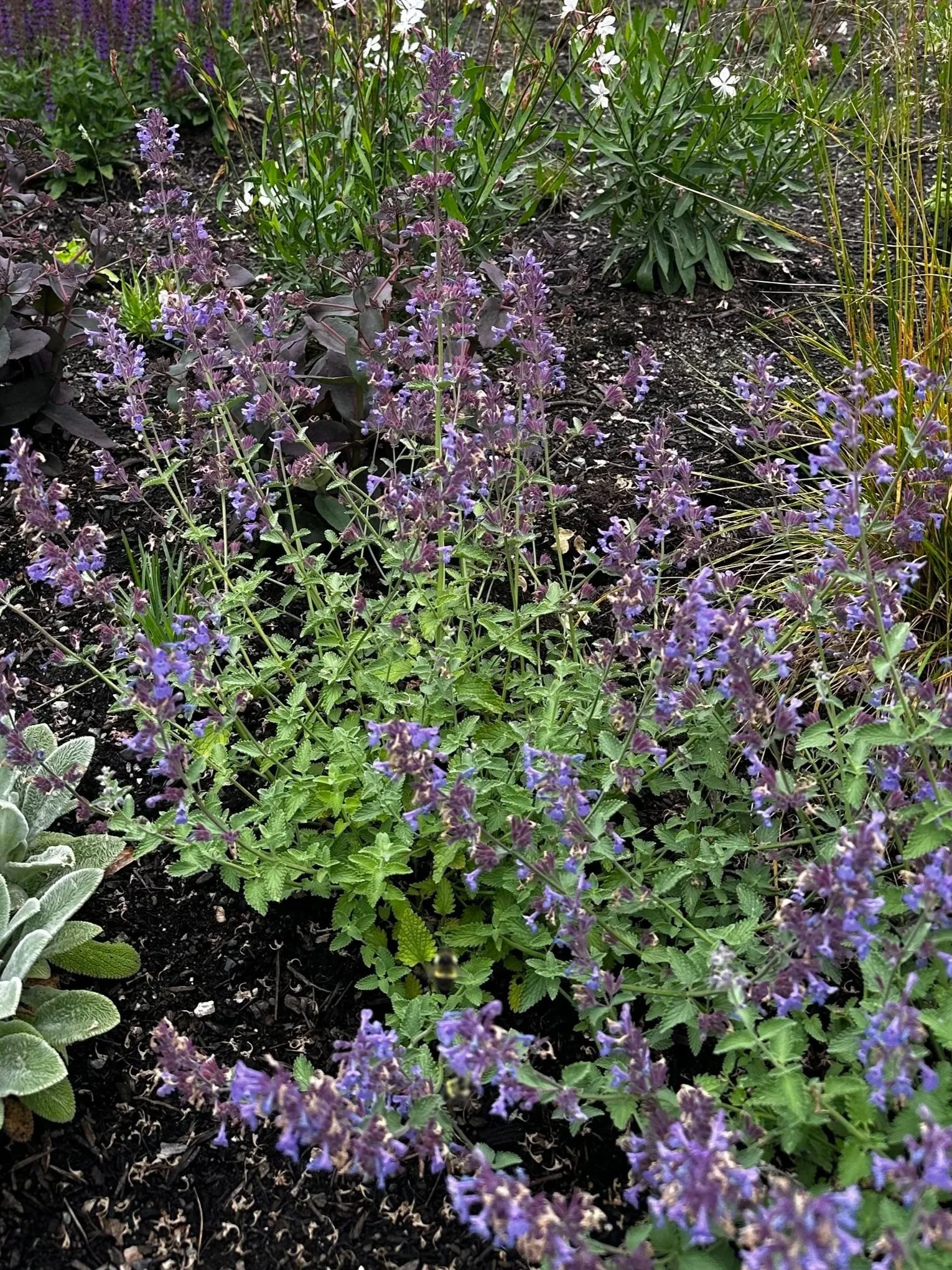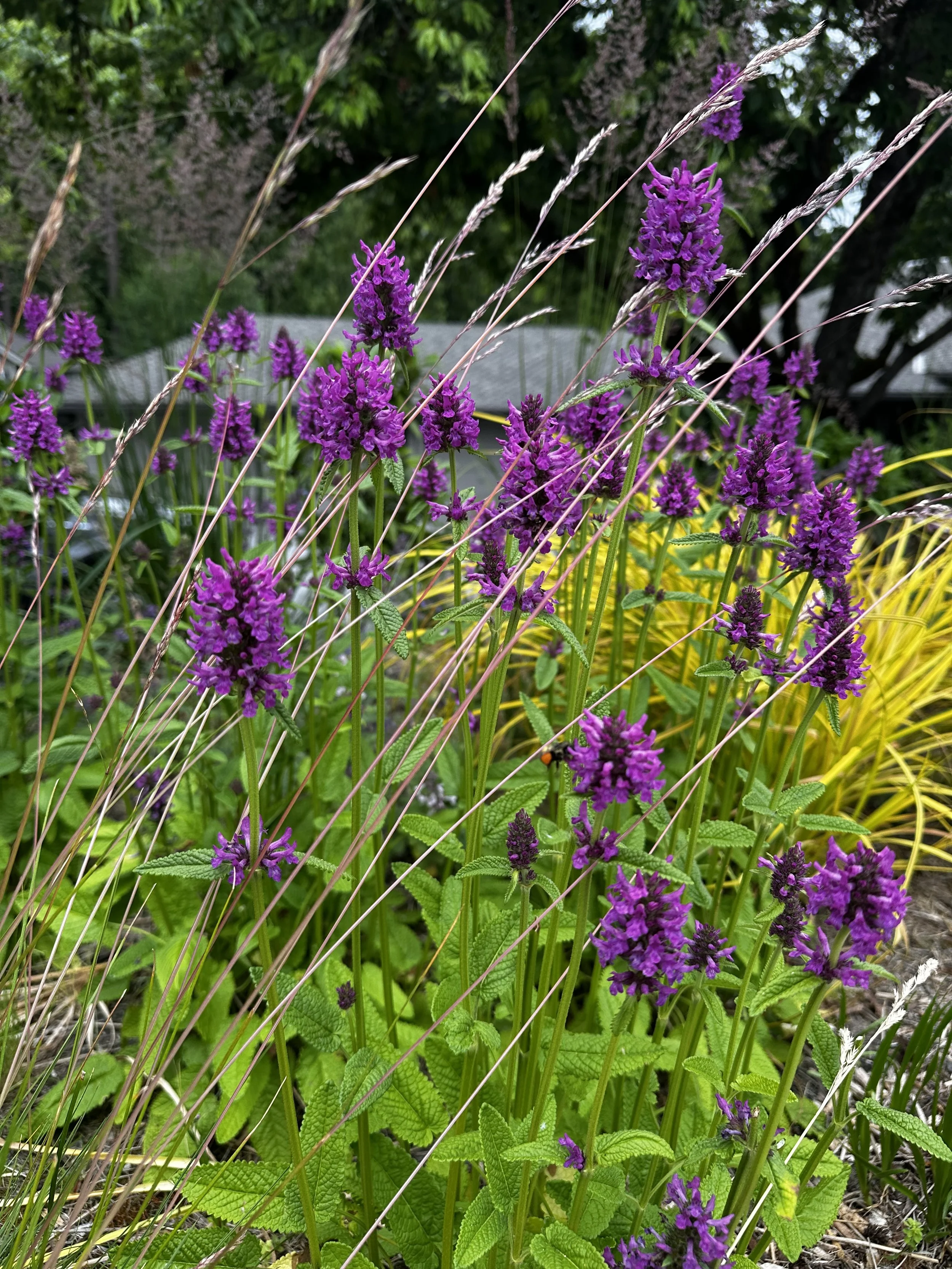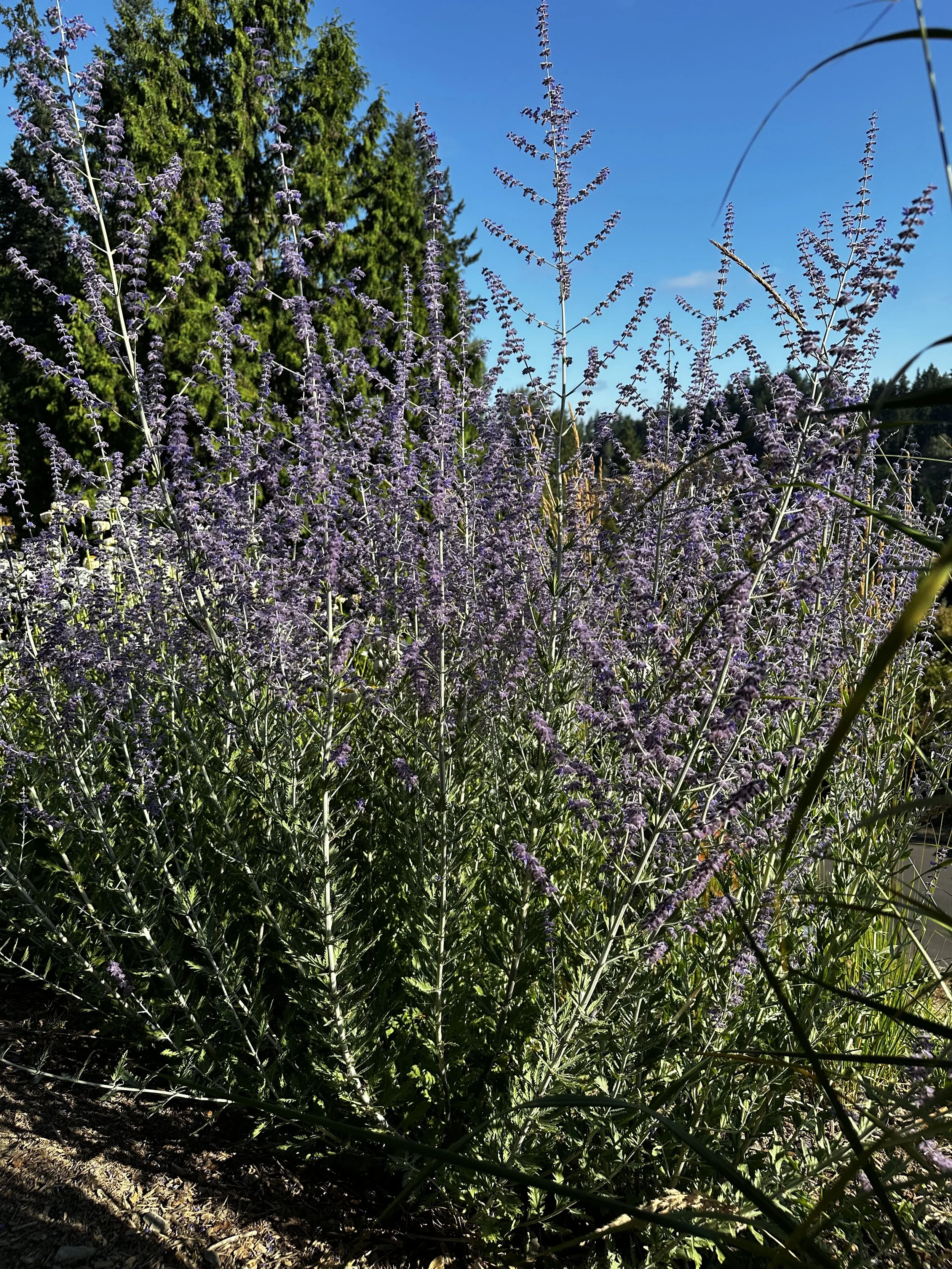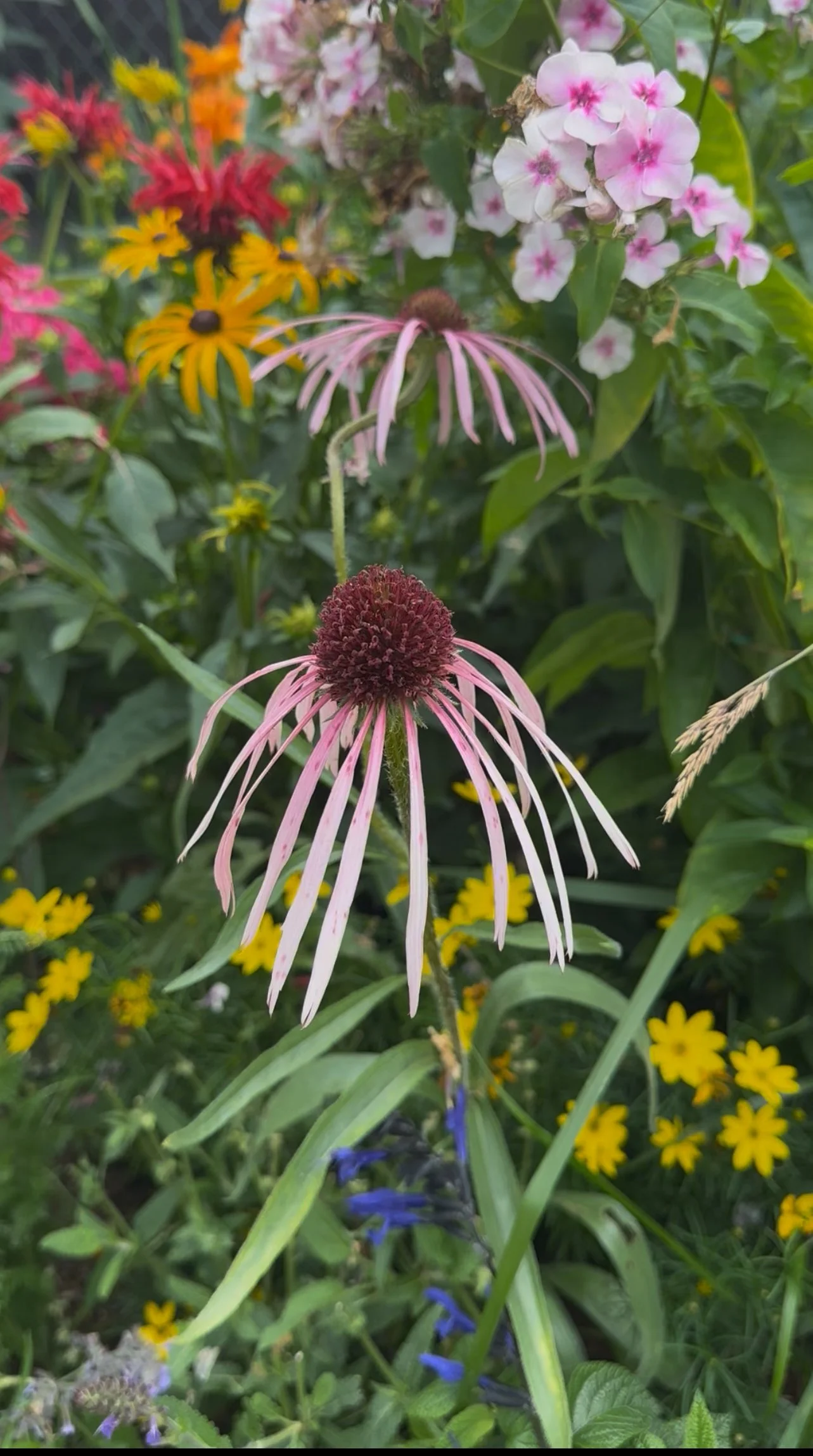10 Plants That Thrive With Zero Watering (After They’re Established)
If you’re designing a low-maintenance garden that thrives on neglect, these 10 perennials are essential. Once established, they’ll need little to no supplemental water — perfect for dry slopes, hellstrips, or sun-drenched meadows.
Below, you’ll find each plant’s strengths, recommended varieties, how to establish them from plugs, and ideas for pairing them in a dynamic, all-season planting matrix.
Echinacea ‘White Swan’ with Magnus in the back
🌿 1. Echinacea (Coneflower)
Recommended varieties:
Echinacea purpurea
Echinacea pallida (for a more naturalistic, wispy look)
‘Magnus’, ‘White Swan’, or ‘Pica Bella’
Why it works: Long blooming from mid-summer into fall. Drought-tolerant once roots are deep, and the seed heads add strong winter structure.
How to plant: Plant 12–18” apart in drifts of 3–7 using plugs. In poor soil, water weekly for the first month, then taper off. Full sun is key.
Pairs well with: Russian sage, Calamintha, Panicum, and Rudbeckia for warm-toned meadows.
🌿 2. Lamb’s Ear (Stachys byzantina)
Lambs Ear
Recommended varieties:
‘Silver Carpet’ (non-flowering, super tidy)
‘Big Ears’ for drama
Why it works: Reflects light and heat with silver foliage. Spreads as a weed-suppressing ground cover. Deer-resistant.
How to plant: Space plugs 12” apart and let them knit together. Avoid overhead watering to prevent rot.
Pairs well with: Sedum, Geum, and Gaura for contrasting textures.
🌿 3. Sedum (Stonecrop)
Sedum Autumn Joy
Recommended varieties:
Sedum ‘Matrona’ – upright with dark stems
Sedum ‘Autumn Joy’ – classic late bloomer
Why it works: Loves lean, dry soils. The fleshy leaves hold water, and fall blooms provide crucial late nectar.
How to plant: Tuck plugs into gravel or sandy soils. Needs excellent drainage. Cut back in spring for tidy regrowth.
Pairs well with: Lamb’s ear, feather grass (Stipa tenuissima), and low grasses like Sesleria.
🌿 4. Salvia nemorosa
Salvia Nemorosa
Recommended varieties:
‘East Friesland’ (compact and intense purple)
‘Caradonna’ (dark stems, upright habit)
‘Wesuwe’ (reliable rebloomer)
Why it works: Attracts bees, reblooms with a simple shear. Adds vertical color and rhythm to the matrix.
How to plant: Start with plugs spaced 12–15” apart. Cut back after blooming to trigger rebloom. Deep roots need time to establish.
Pairs well with: Coreopsis, Stachys ‘Hummelo’, and Achillea for bold color.
🌿 5. Coreopsis (Tickseed)
Coreopsis Zagreb
Recommended varieties:
Coreopsis verticillata ‘Zagreb’ or ‘Moonbeam’
Coreopsis grandiflora ‘Sunray’ for larger flowers
‘Red Satin’ for burgundy contrast
Why it works: Blooms nonstop. Thrives in heat, lean soils, and total neglect.
How to plant: Use plugs spaced 12” apart. Tolerates clay and poor soils. Trim lightly in midsummer for continued bloom.
Pairs well with: Salvia, Nepeta, and ornamental grasses like Panicum virgatum.
🌿 6. Nepeta ‘Walker’s Low’ (Catmint)
Nepeta Walker’s Low
Why it works: Long, blue-lavender spikes from spring to fall. Sprawls gently, softening edges and paths. Scented foliage deters deer.
How to plant: Space 18” apart. Plugs fill out quickly. Shear in midsummer to refresh.
Pairs well with: Stachys ‘Hummelo’, yarrow, and small grasses like Sporobolus heterolepis.
Summer Allium Beauty
🌿 7. Allium ‘Summer Beauty’
Why it works: Clumping onion relative with purple orbs in summer. Pollinators adore them. Tidy, glossy green foliage.
How to plant: Plugs form neat clumps within one season. Space 10–12” apart. Water regularly until roots are strong.
Pairs well with: Stipa, Nepeta, and Calamintha for a light, airy combo.
🌿 8. Stachys monieri ‘Hummelo’
Stachys Hummelo
Why it works: Magenta spikes on dense, glossy green clumps. Upright form adds structure. Great as a mass.
How to plant: Space plugs 12” apart for a cohesive drift. Full sun preferred, tolerates dry soil once settled.
Pairs well with: Echinacea, Calamintha, and Sesleria autumnalis.
Calamintha Nepeta
🌿 9. Calamintha nepeta
Why it works: Delicate white flowers that shimmer like mist. Bees go wild. Airy filler plant that adds rhythm.
How to plant: Space 12” apart. Plugs grow fast. Cut back in early spring. Doesn’t mind lean, rocky soils.
Pairs well with: Allium ‘Millenium’, Russian sage, and grasses like Pennisetum or Muhlenbergia capillaris.
🌿 10. Russian Sage (Perovskia atriplicifolia)
Russian Sage
Recommended varieties:
‘Blue Spire’ – tall and architectural
‘Little Spire’ – compact for tighter spaces
Why it works: Tall, silver, fragrant, and wispy with bluish-lavender flowers that bloom for weeks.
How to plant: Use plugs 18–24” apart. Requires full sun and good drainage. Water first few weeks, then let it go.
Pairs well with: Echinacea, sedum, and prairie grasses like Schizachyrium scoparium.
🌾 How to Use Plugs in a Matrix Planting
Start with 2–3 anchor grasses like Karl Foerster, Sesleria autumnalis, or Bouteloua gracilis. Plant these on a grid, spaced 12–18” apart.
Add seasonal layers using plugs of 5–7 perennials from the list above. Use 3–5 of each species per grouping to create mass and rhythm.
Plant tightly — aim for a full look within 1–2 years. Plugs are cost-effective and establish faster than gallon pots.
Mulch lightly, water deeply the first few weeks, and then taper off. Once established, the garden can thrive without irrigation.
🌼 Final Thoughts
A drought-tolerant matrix planting isn’t just about surviving summer—it’s about creating a thriving, pollinator-rich landscape that looks beautiful in every season with minimal effort. These 10 perennials are easy, affordable to establish via plugs, and endlessly reliable.
💬 Have questions about creating your own no-water matrix? Book a virtual or in-person garden consult, and I’ll help you select the right species and layout a custom planting plan. https://www.shanellerabichev.com/consultation
